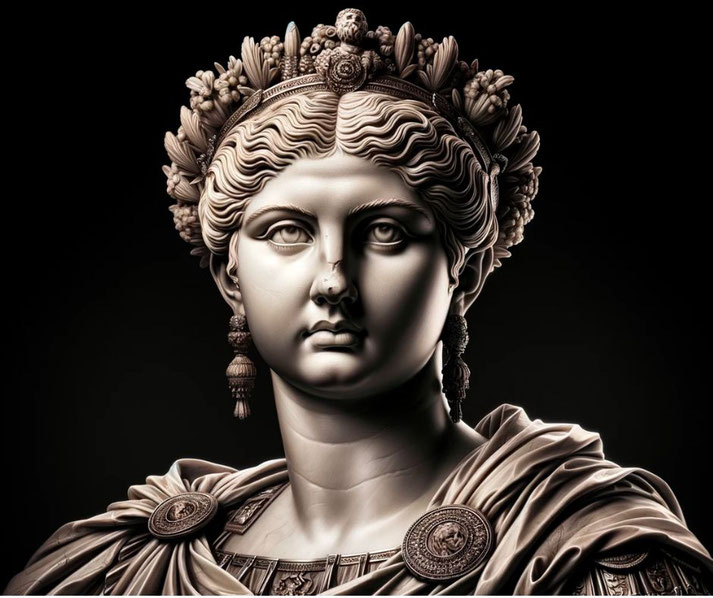Nero's constant attempts to murder his own mother ... and the spectacular ways they failed

Emperor Nero's reign remains one of the most fascinating periods in Roman history. His ascent to power was as dramatic as it was unprecedented, setting the stage for a rule that would be remembered for its extravagant excesses, ruthless political maneuvers, and a shocking final act of matricide.
What was Nero's relationship with his mother, Agrippina?
How did a young emperor, once guided by her, turn against her with such lethal intent?
And what series of events led to the repeated attempts on Agrippina's life?
Who were Nero and Agrippina?
Nero, born Lucius Domitius Ahenobarbus on December 15, 37 AD, was the last Roman emperor of the Julio-Claudian dynasty.
He ascended to the throne in 54 AD after the death of Emperor Claudius, his great-uncle and adoptive father.
Nero's reign, which lasted until his death in 68 AD, is often remembered for its excesses and tyrannical rule.
His mother, Agrippina the Younger, born in 15 AD, was a prominent figure in Roman politics.
A member of the Julio-Claudian dynasty, she was well-versed in the intricacies of power dynamics in Rome.
Agrippina's influence was pivotal in Nero's rise to power. She was married to Emperor Claudius, and it was her ambition that led to Nero's adoption by Claudius in 50 AD, making Nero the heir to the throne over Claudius's biological son, Britannicus.
Nero's education was entrusted to Seneca the Younger, a renowned stoic philosopher, and he was also mentored by Sextus Afranius Burrus, the Praetorian Prefect.
These early years were formative for Nero, shaping both his intellectual and leadership qualities.

Nero's rise to power and Agrippina's role in it
Nero's ascent to the Roman throne was a meticulously orchestrated affair, primarily driven by his mother Agrippina's ambition and political acumen.
Following his adoption by Emperor Claudius in 50 AD, Nero was put in line for succession, surpassing Claudius's biological son, Britannicus.
Agrippina's marriage to Claudius in 49 AD and her subsequent maneuvers were key in positioning Nero as the preferred heir.
This strategic placement was not only a reflection of her ambition but also a testament to her understanding of Roman power dynamics.
Nero's rise was further solidified through his marriage to Claudius's daughter, Octavia, in 53 AD, intertwining his claim to the throne with the imperial family's lineage.
The young Nero, under the guidance of his tutors, Seneca the Younger and Burrus, was being shaped into a suitable future emperor, with a focus on political and cultural education.
The turning point came with the death of Emperor Claudius in 54 AD, an event shrouded in suspicion, with many historians believing that Agrippina played a role in his demise through poisoning.
With Claudius's death, Nero, at the age of 17, ascended to the throne. His accession on October 13, 54 AD, was met with general approval, as the Roman populace and the Senate were optimistic about the young emperor's potential.
Nero was presented as a refreshing change, particularly because of his youth and the promise of a new direction for the empire.
The initial years of Nero's reign, often referred to as the "Quinquennium Neronis," were marked by relatively sound governance and stability.
During this period, Nero was heavily influenced by his mother, as well as his advisors Seneca and Burrus.
These early years saw several positive reforms and a general adherence to the principles of the Roman constitution.
Nero's administration focused on diplomacy, trade, and enhancing the cultural life of the empire.
He was also known for his public performances in poetry and music, reflecting his personal interests in the arts.

Why did Nero turn against his mother?
Initially, Agrippina wielded considerable influence over Nero and the affairs of the empire, guiding the young emperor in the intricacies of Roman governance.
However, as Nero grew into his role and began to assert his authority, tensions between mother and son escalated.
One of the early signs of this shift was Nero's gradual distancing from his mother's counsel.
Agrippina, who had been a dominant figure in Nero's early rule, found her influence waning as Nero started to rely more on his advisors like Seneca and Burrus.
This decline in her power was partly due to Nero's desire to govern independently and to break free from his mother's control.
Agrippina's strong personality and her attempts to maintain a grip on political power increasingly became a source of annoyance and embarrassment to Nero.
The situation deteriorated further when Agrippina began to show support for Britannicus, Claudius's biological son, as a potential rival to Nero.
This move was perceived as a direct threat to Nero’s position as emperor.
The sudden and mysterious death of Britannicus in 55 AD, only a day before he was to be proclaimed an adult, deepened the rift.
Although Nero was suspected of being involved in his stepbrother's death, the incident also marked a turning point in Nero's relationship with Agrippina, as it eliminated a potential challenger to his throne.
As Nero established himself more firmly as emperor, he sought to reduce Agrippina's influence in the imperial court and in Roman political life.
He removed her from the palace, took away her guards, and reduced her entourage, effectively isolating her from the centers of power.
This shift was not only a political maneuver but also a personal reaction to what Nero perceived as his mother's overbearing nature and her interference in his personal and political life.
Agrippina’s response to her diminishing power was a mix of outrage and attempts to regain influence, including possibly seeking alliances with others who might be sympathetic to her plight.
Her actions, however, only served to exacerbate the situation, leading to further estrangement from her son.
The first attempt on Agrippina's life
The first known attempt on Agrippina's life by Nero, as recounted by ancient historians, was as intricate as it was audacious, involving a collapsible boat designed to kill Agrippina in what was supposed to look like an unfortunate accident.
This attempt is believed to have taken place around 59 AD. Nero invited Agrippina to Baiae to celebrate a festival.
The choice of a public event was a strategic move by Nero, intended to mask his true intentions and to reinstate a semblance of normalcy in their strained relationship.
Agrippina, unaware of the impending danger, accepted the invitation.
The plan involved a specially constructed boat, which was designed to collapse on command.
The idea was that Agrippina's death would appear to be a tragic accident, thereby absolving Nero of any suspicion in the matter.
Following the festivities, Agrippina was provided with this boat for her return journey.
However, the plot did not unfold as Nero had intended. The mechanism designed to collapse the boat malfunctioned, and although the boat did break apart, Agrippina managed to survive.
She swam to safety or was rescued by passing fishermen, depending on the historical account.
The failed attempt left Nero in a precarious position. Agrippina's survival meant that she could potentially expose Nero's involvement in the assassination attempt.
Furthermore, the failure of the plot likely fueled Agrippina's suspicions about her son's intentions, further deepening the animosity between them.

The second and third attempts to kill her
Nero's next inclination was to use poison, a method as discreet as it was deadly.
However, Agrippina was well aware of the toxic intrigue that permeated the Roman elite and reportedly took antidotes regularly to protect herself.
This precautionary measure rendered Nero’s initial attempts at poisoning unsuccessful.
Agrippina's vigilance and foresight in anticipating such threats from her son highlight the deeply rooted mistrust and treachery that characterized their relationship.
Frustrated by the failure of the poison, Nero resorted to a more dramatic and elaborate scheme.
He planned for the ceiling of Agrippina’s bedroom to collapse while she slept.
This plan was designed to kill her in a way that would appear to be an unfortunate accident, absolving Nero of suspicion.
The idea was to rig the ceiling with a mechanism that could be triggered to collapse at a moment's notice.
However, this plot was also foiled. The exact manner of its failure is not clear in historical accounts — whether Agrippina learned of the plot beforehand or whether it was simply unsuccessful due to technical reasons.
These failed attempts are indicative of Nero's growing desperation to remove his mother from the political equation.
Agrippina's survival of these assassination attempts only served to further strain their already fraught relationship.
The measures Nero took reflect his deep paranoia and determination to hold on to power at any cost.

When all else fails...
After multiple failed attempts, Nero finally decided to rely on a simple plan: one marked by its directness and brutality.
Having exhausted more covert methods, Nero resorted to a plan that left no room for error or survival.
Nero's successful plot involved a trusted and ruthless accomplice, Anicetus, who was the commander of Nero's fleet and had previously served as Nero's tutor.
Anicetus was chosen for his loyalty and willingness to carry out the emperor's grim orders.
Nero and Anicetus devised a plan that was simple yet effective: Agrippina was to be killed in her own home, under the guise of an accident.
To ensure that there would be no suspicion cast upon him, Nero created a pretext for reconciling with his mother.
He sent friendly letters and gifts to Agrippina, lulling her into a false sense of security and making her believe that their strained relationship was improving.
This ruse was crucial for ensuring that Agrippina would lower her guard.
On the night of the assassination, Anicetus and his men arrived at Agrippina's villa.
They were admitted without suspicion, due to the pretense of delivering a message from Nero.
Once inside, they carried out the deadly mission. Agrippina was killed, and the manner of her death was staged to look like an accident.
Reports vary on the exact method of her murder, with some accounts suggesting she was stabbed, while others imply that she was clubbed to death.
Following Agrippina's death, Nero and his associates quickly spun a narrative to cover up the murder.
They claimed that Agrippina had committed suicide following a plot to kill Nero, a story that was met with skepticism by many contemporaries.
How did the murder impact Nero's reign?
The murder also had implications for Nero's relationship with the Roman Senate and the governing class.
While the Senate had little choice but to publicly support Nero, given his absolute power, there was growing unease and resentment among its members.
The senators were forced to publicly praise Nero and condemn Agrippina, which many did with reluctance and fear.
This episode deepened the divide between Nero and the Senate, contributing to a climate of distrust and suspicion in Roman politics.
The act of matricide was not only a political crime but also a severe violation of Roman family and moral values.
Agrippina, despite her political ambitions and manipulations, was still Nero's mother, and her murder was seen as an unnatural and unforgivable act.
This significantly tarnished Nero's image among the people, who began to view him with a mix of fear and disdain.
Moreover, the manner in which Nero handled the aftermath of the murder, including the spreading of rumors that Agrippina had plotted against him and her subsequent demonization, was viewed with skepticism.
The Roman populace, well-versed in the politics of their leaders, could see through the thinly veiled attempts at justification.
This led to a decline in Nero's popularity and credibility, which was only exacerbated by his increasingly erratic and extravagant behavior in the years that followed.
What do you need help with?
Download ready-to-use digital learning resources
Copyright © History Skills 2014-2024.
Contact via email
With the exception of links to external sites, some historical sources and extracts from specific publications, all content on this website is copyrighted by History Skills. This content may not be copied, republished or redistributed without written permission from the website creator. Please use the Contact page to obtain relevant permission.





